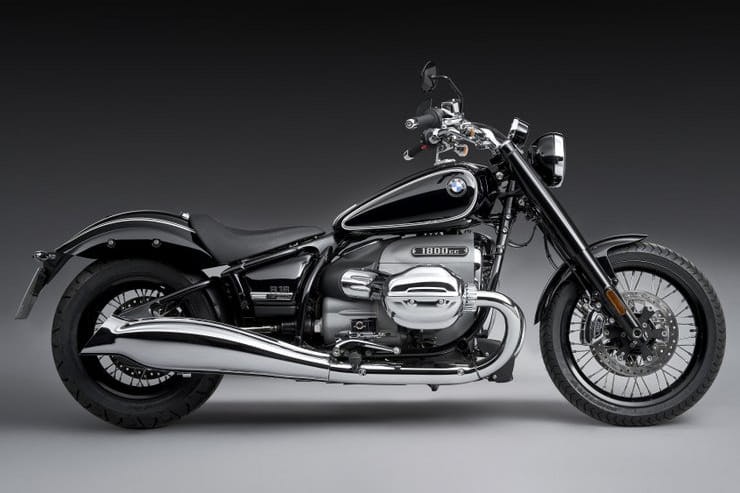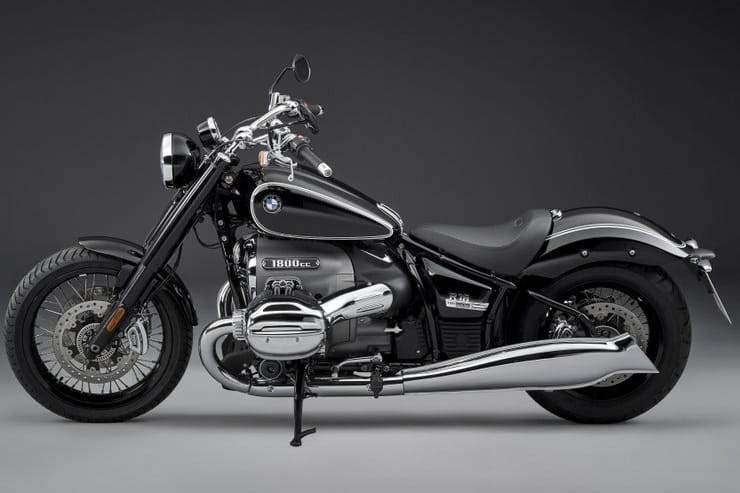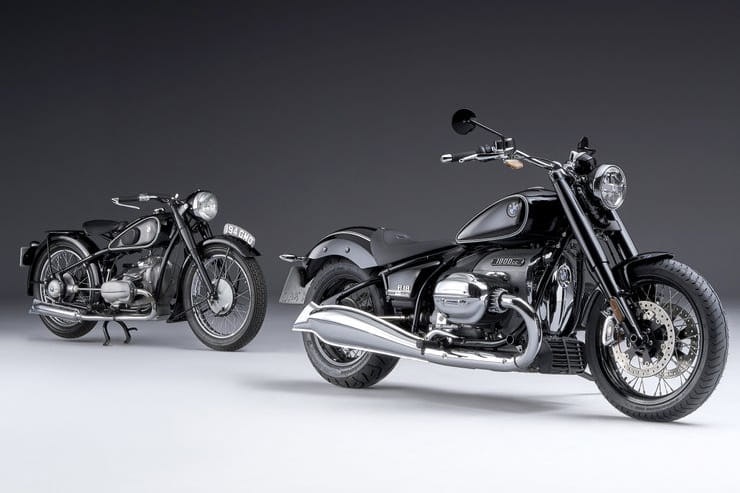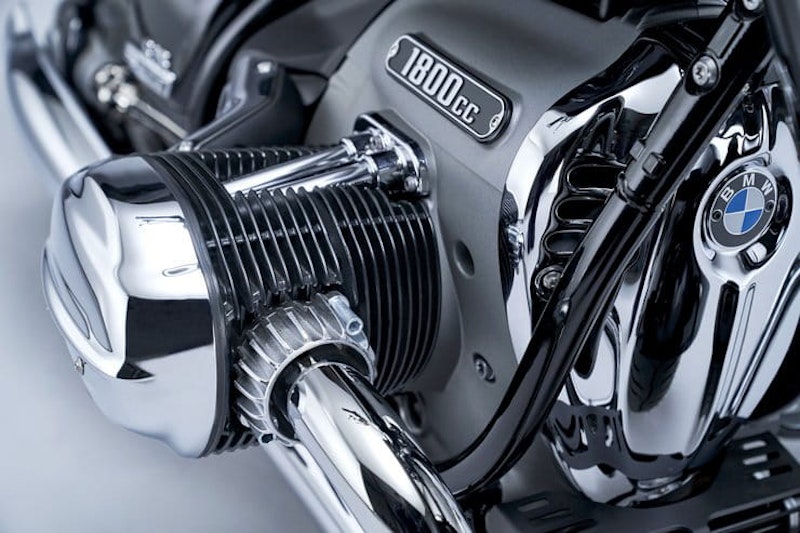Official: BMW R18 breaks cover
By Ben Purvis
Motorcycle Journalist
03.04.2020
It’s been 16 years since BMW announced that its last attempt at a cruiser – the R1200C – was being discontinued. At the time the firm promised it would come back to cruisers one day and while it’s taken longer than anyone expected there’s no denying that the new R18 is a vastly more convincing machine than its long-deceased predecessor.
In fact, while the bike is clearly a cruiser in terms of its spec, BMW is drawing heavily on its own heritage to make a bike that should appeal to a wider market than any Harley-Davidson clone could hope for. Where the old R1200C was a mess of liberally-applied chrome and mismatched cruiser clichés, the R18 is a comparatively understated machine that lets its massive proportions do the talking rather than trying to grab attention with shiny baubles.
The result is a bike that is as likely to steal Triumph Bonneville customers as it is to sway Harley or Indian buyers.
That engine
The R18’s centrepiece is, of course, its engine. The 1802cc air and oil-cooled power unit is the biggest boxer twin ever to go into a bike and mixes old and new technology.
The air cooling and pushrod-operated overhead valves might seem anchored in a world that disappeared several decades ago, but they’re actually ideal for this application. The engine’s massive width would be increased even further if BMW used overhead camshafts, and since high revs and massive peak power aren’t its targets, they’d offer no advantage over pushrods and rockers.
Despite the old fashioned way of operating them, there are still four valves per cylinder and two camshafts, which allow the pushrods to be shorter. There are four spark plugs, too – a pair for each cylinder to help ensure consistent combustion across their vast piston area.
With a 107.1mm bore and 100mm stroke, the engine is slightly over-square, but it’s still a low-revving slugger that redlines at just 5750rpm. Not that you’d need to go that far, since peak power of 91hp arrives 1000rpm before then. Instead the engine will encourage you to ride a tsunami of torque, peaking at 116.5lbft at just 3000rpm and staying above 110.6lbft all the way from 2000rpm and 4000rpm.
A hefty flywheel should add to the feeling of torque, which it transmits to a six-speed transmission that drives the rear wheel via a stylish exposed drive shaft. An electrically-driven reverse gear will be an optional extra, and given the bike’s hefty 345kg mass it’s probably a sensible one to tick unless you’re after a workout whenever wheeling the bike around the garage.
Chassis and electronics
The frame follows the likes of Harley’s Softail and Triumph’s Bonneville Bobber in using a hidden rear shock and a tubular structure that’s designed to look like an old-style hardtail chassis.
The shock actually hides behind the bike’s side panels, and lies almost horizontally between the upper rear frame rails, just under the rider’s seat. BMW has opted not to add gizmos like electronic adjustment, so instead there’s just a preload setting to play with. The 90mm of rear suspension travel is actually more than you might imagine from the look of the design, and promises a decently luxurious ride. Up front, the forks have 49mm tubes and offer 120mm of travel.
As standard, the R18 gets wire spoked wheels – 19in at the front clad in a 120/70 tyre and 16in at the rear with 180/65 rubber – but as we’ll see there are plenty of alternative options.
On the electronics side, BMW has given the R18 LED lighting and there’s an optional cornering headlight that changes its beam depending on lean angle. Keyless ignition is standard, as are three riding modes, which are cringingly titled ‘rain’, ‘rock’ and ‘roll’. ‘Rain’ is self-explanatory and softens throttle response while increasing traction control and the bike’s ‘MSR’ engine drag control to stop the rear wheel locking on a closed throttle. ‘Rock’ is for spirited riding, with sharp response and dialled-back traction control, while ‘roll’ is a middle setting.
Hill Start Control is an option, holding the bike’s weight on slopes at a touch of the front or rear brake until you’re ready to pull away.
The simple-looking instrument display combines an analogue speedo with hidden warning lamps that can’t be seen until they light up. A small digital element shows the selected riding mode, gear position and a choice of other data like outside temperature and on-board computer readouts.
Styling
As we’ve mentioned, BMW isn’t following the cruiser herd with the R18’s styling. The bike is relatively restrained in stock form and notably short on chrome. The proportions are inspired by BMW’s pre-war R5 model rather than traditional cruisers.
The engine’s shape is also inspired by older BMW boxers, and the firm has paid attention to concealing wiring and pipework to keep the look as clean as possible. The nickel-plated, exposed drive shaft is a unique touch.
BMW makes much of the ‘mid-mounted’ footpegs, but they’re a decision that’s forced on the bike by its massive boxer engine; there’s simply no way that Harley-style forward-mounted pegs could be fitted for a more traditional cruiser riding position. In standard form, it’s not likely to be a problem, but the pegs’ position looks a little odd – particularly with a rider aboard – when options like ape-hanger bars are chosen.
But was the engine layout a consideration with foot-peg placement in mind? We asked the R18 Project Leader, Gerd Wösle, “Based on the history of BMW Motorrad, it was clear from the outset: the boxer engine is an absolute BMW icon. This is why there was no alternative for the R 18 and no other concepts were taken into consideration.
“In keeping with the BMW Motorrad philosophy, the new BMW R 18 features a laid-back positioning of the footrests – so-called ‘mid-mounted footpegs’ This classic position behind the cylinders of the boxer engine is not only typical of BMW, it also allows a relaxed and active riding position for the best possible motorcycle control. The range of BMW Motorrad Original Accessories includes footboards and additional footrests, while the BMW Motorrad equipment programme has numerous options for adapting the R 18 to individual ergonomic requirements by means of various handlebars and seats.”
Initially, the R18 will be offered in ‘First Edition’ form, finished in ‘Blackstorm Metallic’ and with pinstripes. It also gets extra chrome – still not a lot of it – special badges and comes with a ‘welcome box’ for buyers that includes special ‘historical’ tank emblems with copper-coloured lettering, copper coloured screws to attach them, ‘assembly gloves’ to do the job, a keyring screwdriver, an ‘R18 First Edition’ cap and belt, and a book about BMW’s history.
Customisation
By their nature cruisers are blank canvasses for modification and BMW is taking that seriously with a vast array of options and some clever design details that make for easy changes to the bike’s appearance.
As well as the usual stuff like a variety of seats and handlebars, BMW is letting buyers transform the appearance of their R18s by changing the wheels – 16in, 18in, 19in and 21in front wheel options are available, with wire and alloy options, along with different mudguards to suit them. There’s also a bobber-style rear wheel cover to replace the standard fender and a variety of cylinder head covers and silencer designs.
On the handlebar front there’s a variety of risers on offer plus three different styles of bars. There are three windshields on offer as well, along with auxiliary lights, footboards – albeit not forward-mounted ones – and luggage including a tank bag, side bags and a rear bag.
BMW has added connectors for the electronics and hydraulics to allow the bars to be easily removed and swapped for different ones with longer or shorter harnesses to suit the replacement’s height. The engine’s visible rocker covers are also decorative outer parts with function inner versions hidden behind them so there’s no need to disturb gaskets when changing the engine’s appearance.
A selection of optional milled alloy parts designed by Roland Sands has also been created, with two ranges – ‘Machined’ and ‘2-Tone Black’ – on offer. ‘Machined’ components are black and silver, with polished alloy finish on the exposed metal, while ‘2-Tone Black’ parts have gloss and matt black elements. The ranges include wheels, speedo housings, levers, mirrors, silencer covers and engine trim parts.
What next?
To be honest, we’re a bit surprised that BMW has only revealed one version of the R18 at the moment since the firm has already type-approved a second version – the R18 Classic – as a 2020 model.
The Classic seems certain to be the part-faired touring version that was revealed earlier this year in official design patent renderings. Complete with a bar-mounted fairing, fixed, hard panniers, a fully-stocked instrument display and a larger fuel tank than the 16-litre unit that comes on the initial R18, the touring model will compete with the likes of Harley’s Electra Glide Standard. Type-approval specs show the R18 Classic will be 20kg heavier than the 345kg R18, coming in at 365kg ready-to-ride.
Share on social media:



